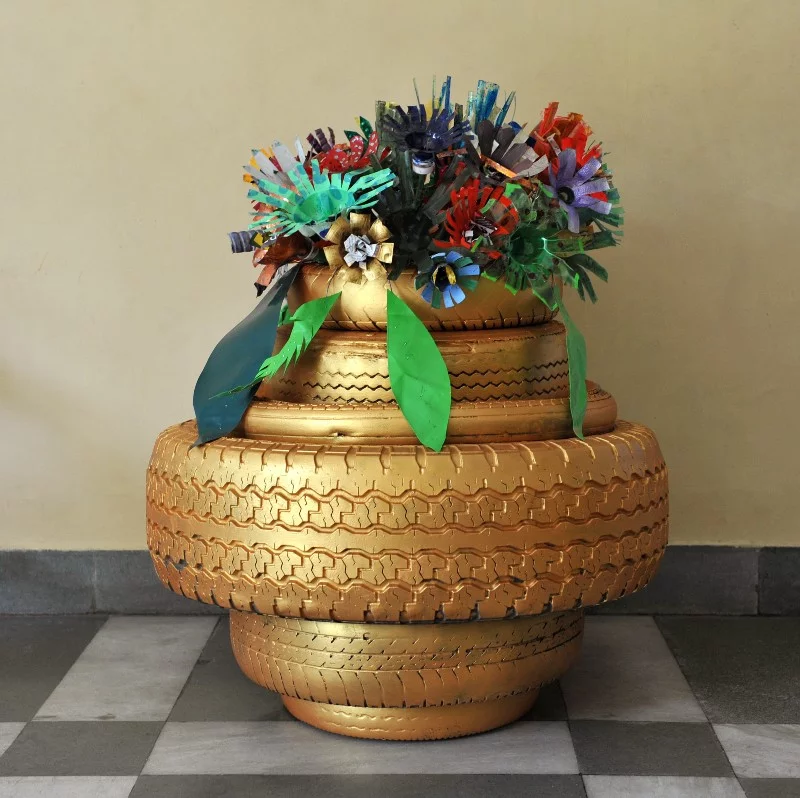Garbology is something my husband, Len, got me interested in years ago. At first, I was horrified at the thought of it. But as I went on runs with him and experienced the wonders of it, I became an advocate of it.
What’s garbology?
What is garbology – technically it is the understanding of human behavior by analyzing what people throw away. But popular usage of this word now refers to the idea of taking old items that are no longer useful for their originally intended function and using those items as a resource with which to create a new item. The following picture is of a tire that was made into an artwork by children. This picture is courtesy Ribhu Vohra and Chandrah Nusselein from Pondicherry. They formed WasteLess India in 2011. The team in 2012 trained school teachers to understand and link different topics and to use garbology effectively. Garbology 101 currently reaches 32,000 students in 37 private and aided schools in Andhra Pradesh, Delhi, Pondicherry, Madhya Pradesh, Kerala, Karnataka and Uttarakhand.

A divine twist
Len used to take old, defunct tires and place them in the garden. We used these to grow potatoes. The advantage of this was that you can easily take the tire off and harvest the potatoes. I would like to share with you one experience I had with him concerning garbology. We attended a Sathya Sai Baba center meeting. Someone there mentioned that a family needed a piece of furniture He knew of our interest in Garbology and was sure that we could find the piece the family was searching for. We weren’t so sure.
Well, one day when we were on one of our searches we spotted a license plate that read ‘Lucky Day.’ The practice of customizing license plates is common in USA. I told Len to follow that car. At one point it veered off the road it had led us onto. Due to an inexplicable instinct, we kept going straight. Lo and behold! Right before our very eyes there was a piece of furniture the family was looking for, All we had to do was paint and deliver it. Garbology showed us how fast the universe can answer prayers.
Remember what Maria did with the curtains in Sound of Music? I did too
Here is another example of how we used garbology. Len used to work for Allstate, an insurance company. The company was going to redecorate their dining room and were in the process of trashing their existing curtains. He asked permission to salvage them and brought them home in his truck. I made curtains out of them for every room in my home in the USA and in India, two sets of bedspreads, a complete futon cover for a couch and even gave some material away to an elderly person who would make things out of them.

Would you like a recycled house?
I would like to describe to you some other things that people have done with garbage. This is a great way to keep things out of the landfill. An article appeared in National Geographic in April 1983 discussing how architect Michael Reynolds was bulding houses using empty beverage cans, beer bottles and tyes. He used them like bricks at Robor, near Taos, New Mexico. This is a community for low –cost, experimental homes. He used a porthole from a 50-gallon drum for a window; his door handles were made from turpentine cans. Mud-packed tires were used around the home and all its electricity came from a rooftop wind turbine and photovoltaic cells. These homes are now called earth ships. They have now become very popular for people who want to live off the grid and as sustainably as possible.

Akbar Birbal and Garbology
The use of Garbology goes back a long time in India. There’s an Akbar Birbal tale that shows how seriously people took being sustainable, even as far back as the 1500s. One day someone showed Akbar a chipped vase. The emperor replied that he shouldn’t be shown anything broken. When Birbal inquired why, Akbar replied that anything that is broken, crushed or rotten is of no use to anyone. Birbal disagreed. He said that rotten decaying rags, old jute and other wastes yield paper for the sacred Quran and well as our Puranas. Akbar pondered on this piece of wisdom and agreed that even broken, crushed and rotten things are useful.
In conclusion
Composting food scraps is an excellent example of how garbology works. It turns food into potting soil. In the USA there is a trend to take recyclable plastic and turn it into lumbar for outdoor use such as shoes, furniture, fences, and round circle mulch that is porous for keeping weeds out around trees.
Garbology is a great way to teach children about ecology while having fun and practicing sustainability along the way. You can creative using trash materials that can be upcycled to make beautiful home decor items. For example, a simple google search will show you thousands of ways you can turn discarded bottles into gorgeous lampshades. As you shed your inhibitions about working with trash, you will (like me) come to realise what a treasure it can be. And in the process understand that the trashcan is no place for garbage.

